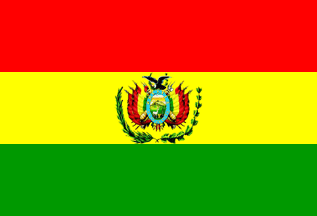Military ranks of Bolivia on:
[Wikipedia]
[Google]
[Amazon]
 The
The
 The
The Armed Forces of Bolivia
The Bolivian Armed Forces ( Spanish: ''Fuerzas Armadas de Bolivia'') are the military of Bolivia. The Armed Forces of Bolivia are responsible for the defence, both of external and internal, of Bolivia and they are constituted by Bolivian Army, ...
has four main branches: Army
An army (from Old French ''armee'', itself derived from the Latin verb ''armāre'', meaning "to arm", and related to the Latin noun ''arma'', meaning "arms" or "weapons"), ground force or land force is a fighting force that fights primarily on ...
, Navy
A navy, naval force, or maritime force is the branch of a nation's armed forces principally designated for naval and amphibious warfare; namely, lake-borne, riverine, littoral, or ocean-borne combat operations and related functions. It in ...
, Air Force
An air force – in the broadest sense – is the national military branch that primarily conducts aerial warfare. More specifically, it is the branch of a nation's armed services that is responsible for aerial warfare as distinct from an ...
and the National Police Force. Each of the four branches has a similar structure, each having four pay grades: non-commissioned officers, senior non-commissioned officers, commissioned officers and general staff. However, the SNCO roles vary depending on the branch; some of these hold specialisations.
Army
The Army trains all its personnel in the following: * Army NCO School, Sucre * Military College of Bolivia, La PazOfficer ranks
Enlisted ranks
Navy
Despite being alandlocked country
A landlocked country is a country that does not have territory connected to an ocean or whose coastlines lie on endorheic basins. There are currently 44 landlocked countries and 4 landlocked de facto states. Kazakhstan is the world's largest ...
, Bolivia has a large quantity of rivers and lakes which the majority of their naval operations take place on, one example of this is Lake Titicaca
Lake Titicaca (; es, Lago Titicaca ; qu, Titiqaqa Qucha) is a large freshwater lake in the Andes mountains on the border of Bolivia and Peru. It is often called the highest navigable lake in the world. By volume of water and by surface area, i ...
, which is shared between Bolivia and Peru
, image_flag = Flag of Peru.svg
, image_coat = Escudo nacional del Perú.svg
, other_symbol = Great Seal of the State
, other_symbol_type = National seal
, national_motto = "Firm and Happy f ...
.
The Navy, unlike the other three branches, has different specialisations for the NCOs and SNCOs once they reach the rank of 'seaman'. Once a specialisation has been achieved, the sailors' insignia will be adjusted slightly, to make his/her profession more visible. Those corps are as follows:
* Machinist Corps
* Medical Corps
* Divers Corps
* Logistics Corps
* Quartermasters Corps
* Signals Corps
Any rank between Seaman and Master Chief Petty Officer can have a specialisation as part of their regular rank insignia, the only corps where the insignia varies is within the Machinist Corps, where both NCO and SNCO have a different insignia, this also helps determine their qualifications and what they are responsible for.
The most Senior Non-Commissioned Officer, Fleet Master Chief Petty Officer, holds no specific specialisation. The SNCO would have been a specialist at a lower rank. This sailor would also be the overseer of each of the Corps, ensuring that this branch's members are fully trained and equipped.
Officer ranks
Enlisted ranks
Air Force
Officer ranks
Enlisted ranks
Historical ranks
The ranks were introduced in 1968, based on design by the Central American Defense Council ( es, Consejo de Defensa Centroamericano; CONDECO). ;Officers ;EnlistedReferences
* * {{Military ranks by country Military of Bolivia Bolivia